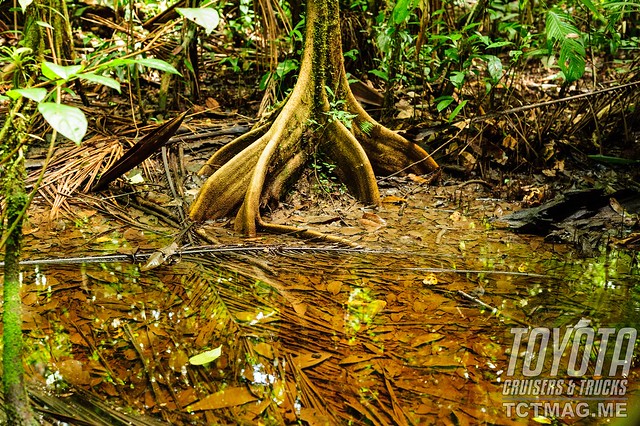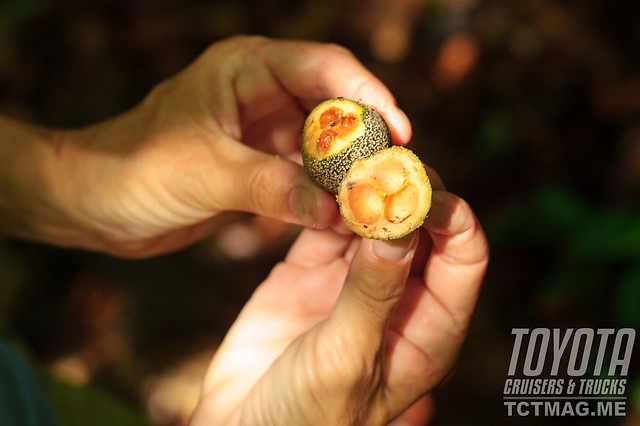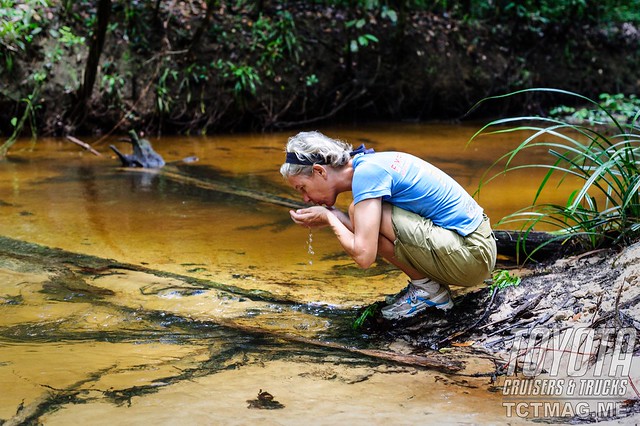

Since it is an overseas department of France, French Guiana is part of Europe and so, yes, the currency is the Euro. With it, you buy delicious French wine, good mustard, and better chocolate than anywhere else on the continent. Properly stocked up, we set out to check out one of the gorgeous parts of the Amazon Rainforest, les Chutes Voltaires (chutes = waterfalls), which lie some 30 or 40 miles from Saint Laurent de Maronie, the border town with Suriname.
We followed asphalt into the countryside. Along the side of the road, like every where in this country, lay rusted and burned out vehicles. Sometimes it looked like a car cemetery. Most of these cars had been stolen by illegal gold seekers who use them to take their gear to the edge of the forest from where they walk into the wilds, leaving the car behind. When the gendarmerie - the French police - find one of these cars, they’ll set it on fire so it can’t be used again. The illegal gold mines are one of French Guiana’s main causes of criminality. When one is discovered, the military will set it on fire and destroy everything on the site.

The mineworkers are mostly illegal Brazilians, who are sent back across the border to their own country. This generally happens without problems or violence. The Brazilians know they will be able to return within a few weeks and start from scratch; the French know that too but can’t stop them. The forest is too big, too vast to controlit all. The Chinese are part of this, too. A high-ranking person once told us how at one point, a big bulldozer had arrived by ship. Months later that bulldozer had been found back deep in the forest at an illegal gold mine. After the bulldozer had been imported, it had been taken apart into the smallest possible pieces, carried into the forest, and been put together again. Where do you start tackling such problems?
Pushing the thought of illegal mine workers to the back of our minds, we focused onthe green surroundings. The road meandered through a landscape that until a few years ago had been rainforest, but which now was being burned down to grow sugar cane and cassava (manioc). Asphalt became a laterite road until a turn off and another four miles to go to Auberge Voltaire. Vegetation thickened with bamboo, ferns and ravenalas - the latter is better known as traveler’s tree (or palm). The nickname is a result of the sheaths of the stem holding rainwater, which can be used as an emergency drinking supply for travelers. Here we encountered some technical off-roading. Apart from potholes, the forest path was deeply rutted and impassible during heavy rains. It had been dry for a couple of days and the soil had hardened. We were in luck.

The ruts caused the Land Cruiser to tilt and we had to watch out the roof rack didn't hit trees or heavy branches. Coen steered with utmost concentration. It was time to get out our machete and ax. Some trees grew too far on a slant and we removed branches before being able to drive on. At one point a dead tree lay across the road, which we moved to the side to clear the path. It took at least two hours to cover four miles. The Land Cruiser squeaked, moaned, screeched, scraped and groaned with all movable, and possibly non-movable, parts. We rolled up the windows when thin branches threatened to smash into our faces. We were on the alert for vines - some as thick as my upper legs - getting stuck behind the high air-intake, possibly damaging it.


We observed sapakaras and other types of lizards scuttling across the path while birds were watching us from above, sitting on branches. When we stopped and turned off the engine, we heard the cicadas scream.
At one of these points I walked ahead a bit, to see what we could expect behind a bend. There, for some twenty meters or more, the vegetation on the right side of the path was entirely covered with snow-white, fine spider silk. I had never seen anything like it. When I touched the cob web, I felt how strong it is, and my touch awakened hundreds of tiny spiders. This whole structure must be home to millions of them. Fascinating! But we didn't want them in the Land Cruiser and carefully removed the part hanging over the path to prevent it from getting stuck behind the roof.

At the auberge (inn) we parked the Land Cruiser, where it could stay for a couple of days. We packed our backpacks and walked into the forest, a few miles to the waterfalls. The trail meandered among 100 to 160-foot-tall forest giants, which they call ‘telephone trees (pali oudou)’, in neighboring Suriname. You hit a piece of wood against the flat trunks when you’re lost and people can hear where you are. In French Guiana, they call the trees ‘bois cathedral’ (cathedral trees) because of their elegant shapes.

At four-thirty, it started to get dark in the forest. Fortunately, we heard the waterfall and the trail was easy to walk. Not much later we arrived at some open huts where we hung our hammocks with a mosquito net around them, like the locals do. Here we had the world to ourselves, being lazy in our hammocks, reading, going for a swim, and for walks deeper into the forest until we were fully rested and ready to return to the world in search of our next adventure.



To get your copy of the
Winter 2020 Issue:
Follow us on Facebook, Twitter, and Instagram to get up-to-date industry news, events, and of course, amazing adventures, stories, and photos!












